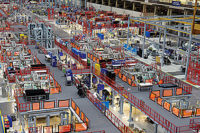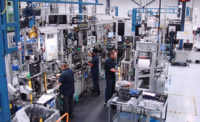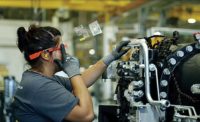Traditionally, airframe assembly has been a manual process. However, that changed more than a decade ago when Northrop Grumman Aerospace Systems adopted production technology from the auto industry and unveiled an automated assembly line to mass-produce fuselages for the F-35 jet fighter.
The facility in Palmdale, CA, that houses the Integrated Assembly Line (IAL) was the recipient of the 2013 Assembly Plant of the Year award. The first-of-its kind operation pairs automated tools and robotics with a highly skilled workforce.
The IAL is comprised of more than 3,000 parts, scalable to 115 assembly positions and capable of completing one center fuselage every 30 hours. The assembly line features unique manufacturing technologies exclusive to or pioneered by Northrop Grumman.
The IAL maximizes robotics and automation, providing additional capacity and assembly capability to achieve high rates of production, while meeting engineering tolerances not easily achieved manually.
“Since 2013, our F-35 IAL rate has increased from 39 center fuselages per year to 156, representing one of the highest production rates for a 5th generation fighter program in existence today,” says Glenn Masukawa, vice president and F-35 program manager at Northrop Grumman. “Our journey followed a disciplined plan to expand the IAL through advanced manufacturing technology, factory automation and additional rate tooling.
“Investments in advanced aircraft manufacturing training programs have also produced a highly skilled workforce supporting numerous programs on our Palmdale campus,” explains Masukawa. “Today, our IAL and F-35 team exemplifies Northrop Grumman’s commitment to quality, safety, customer missions and a culture of continuous improvement.”
In 2022, Northrop Grumman delivered the 1,000th center fuselage produced at the IAL. The company is currently in the process of building a second IAL facility in Weeze, Germany, that is expected to open next year, with deliveries starting in 2027.
The IAL builds center fuselages for all three versions of the F-35 used by the U.S. military and its allies: conventional takeoff (Air Force); short takeoff, vertical landing (Marines); and carrier (Navy). After being assembled and tested, each fuselage is shipped to Lockheed Martin’s factory in Fort Worth, TX, for final assembly.
In addition to the IAL, Northrop Grumman’s secretive plant in Palmdale houses assembly lines that produce the B-21 Raider stealth bomber and the Global Hawk Enterprise family of unmanned systems.
ASSEMBLY recently asked Masukawa to explain how the IAL has evolved over the past decade.
ASSEMBLY: What have been some of the major changes at the Palmdale plant since 2013?
Masukawa: In 2013, the IAL was producing at a rate of 39 center fuselages per year at a production internal of five days. At that time, we had 79 workstations and approximately 290 technicians working two shifts. Today, the IAL has entered full-rate production of center fuselages for the F-35 Lightning II.
The line boasts a 1.25-day production interval. This means one F-35 center fuselage is delivered off the line every 30 hours. We have 112 workstations (scalable to 115) and approximately 900 technicians across four shifts. To date, we have delivered more than 1,000 center fuselages, including all three F-35 variants.
ASSEMBLY: In the past decade, have there been many changes in the design of the F-35 center fuselage? How has this affected the way that the plant assembles and tests its products?
Masukawa: There have been minor F-35 design updates. However, the IAL was designed with flexibility in mind to seamlessly manufacture center fuselages for all three F-35 variants using the same base tooling and processes, resulting in minimal impact to how we assemble and test. We are incorporating new digital technologies such as augmented reality work instructions that project existing models on the aircraft to help technicians visualize systems installations and ensure processes can be replicated precisely each time.
Our culture of continuous improvement also drives opportunities to update processes and approaches if there is a benefit to the quality, schedule and cost of the program. Our workforce has maintained the flexibility to adapt to change and adopt new approaches that benefit our customer by reducing cost and improving delivery times.
ASSEMBLY: How has the IAL changed since 2013? Have you reconfigured or redesigned any part of the assembly line?
Masukawa: In 2008, the Palmdale plant had an eight-day production interval. The production interval improved to three days in 2015 and then again to 1.5-days in 2019. With each acceleration, we evaluated tooling positions, shifts, staffing levels, manufacturing approaches, the make vs. buy mix and more. The journey from 39 center fuselages per year at a five-day production interval to 156 center fuselages per year and a 1.25-day production interval required a number of planned accelerations. We increased the number of total rate positions on the IAL, which has enabled us to support the production interval of 1.25 fuselages per day.
When the line produced its very first center fuselage, it went through 39 scheduled positions. Today, fuselages go through 104 scheduled positions that were added to improve the fidelity of our cost and schedule management. We’ve also made decisions about subassembly work, sending more work to Northrop Grumman remote sites that in turn become suppliers to the IAL.
ASSEMBLY: Has the use of automation on the IAL increased in the past decade? Have you invested in any new type of robotic tools or systems?
Masukawa: The IAL maximizes robotics and automation, providing additional capacity and assembly capability to achieve high rates of production, while meeting engineering tolerances not easily achieved manually. We have standardized automated drilling processes across the IAL’s build stations and added additional drilling stations to support increased production rates. In 2014, we began using a robotic mold-in-place process to further streamline F-35 center fuselage manufacturing.
Our involvement on the F-35 program enabled us to explore and employ automated and digital systems throughout the manufacturing process at Palmdale and across our 61 manufacturing hubs around the country, which underscores the IAL’s innovative nature and commitment to advancements that brings benefits to our customers.
ASSEMBLY: How has material handling and parts flow changed in the plant since 2013?
Masukawa: We utilize automated storage and retrieval systems for material handling and parts on the IAL, which helps streamline the processes for our technicians. One example of a key IAL material handling process is the use of “shadow boxes” containing foam cutouts for the specific parts technicians need to install on each center fuselage. Once the part is installed, a new box arrives with parts for the next variant coming down the line.
ASSEMBLY: What new types of Industry 4.0 tools and production technology have you installed recently?
Masukawa: Our implementation of digital solutions across our business is transforming how we design, test and manufacture the next generation of systems, and is driving improved performance and productivity across our company. We’ve built a digital ecosystem where digital technologies are woven throughout our products from design to sustainment. We leverage advanced manufacturing techniques and a digital collaboration environment to design, produce and test with speed and agility.
The IAL is a unique combination of highly skilled workers with advanced automated manufacturing technology that produces a crucial component of an advanced aircraft. We have deployed shop floor digital technologies across many of our manufacturing hubs, such as projected and wearable augmented reality devices, to help technicians see work instructions while completing tasks, ensuring proper installation of components and high-quality production for each fuselage.
ASSEMBLY: The IAL was innovative back in 2013. How is it still “raising the bar” today?
Masukawa: The F-35 center fuselage IAL continues to be one of the most advanced manufacturing facilities used to produce military aircraft. Our team always looks for opportunities to apply modern manufacturing technologies that make our build process more efficient and affordable. As one of the world’s premier aircraft and defense technology providers, Northrop Grumman is continuously looking to the IAL for processes, technologies and lessons learned that are being incorporated into other production lines across our company.
ASSEMBLY: What type of initiatives are you currently working on to improve productivity, quality and throughput in the Palmdale plant?
Masukawa: Across our company, we are consistently leveraging advanced manufacturing techniques and a digital collaboration environment to design, produce and test with speed and agility. We are leveraging new technologies and processes that ensure high-quality production of F-35 center fuselages. These innovations include the use of automated liquid shim systems, implementation of measuring arms for seam validation and other processes that ensure flushness across the center fuselage.
ASSEMBLY: Will the new IAL currently being built in Germany be similar or different than the facility in Palmdale?
Masukawa: We are collaborating with Rheinmetall AG in a first-of-its-kind German-American defense collaboration. This facility will utilize the same automated and advanced manufacturing technologies currently in use at our Palmdale site as a second-source supplier for F-35 center fuselages. The center fuselages supplied from Rheinmetall will help bolster our production capabilities to meet growing demand for these 5th-generation fighters around the world. Approximately 400 employees, including manufacturing technicians, mechanical and process engineers, program managers, supply chain staff and other support roles for the program, will be hired at the Weeze location.
Northrop Grumman has manufactured some of the world’s most advanced aircraft, and innovations like the IAL are continuously incorporated into future production lines. Through new collaborations with global industry, we are poised to continue a track record of advanced manufacturing excellence to meet the demand from allies for cutting-edge airpower capabilities.
Click here to learn more about the Assembly Plant of the Year award or to nominate a facility for 2024 (the deadline is May 1).




